Parker Thermal And Power Management
Parker’s thermal and power management technology offers comprehensive solutions for the complex challenges of heat management in today’s advanced applications. As medical equipment, power electronics and other high heat applications become faster and smaller, the need for thermal management solutions increases significantly. Ranging from thermal compounds and pads to heat transfer and cooling systems, Parker’s thermal management products can reduce heat efficiently, cost effectively and at virtually any size or scale.
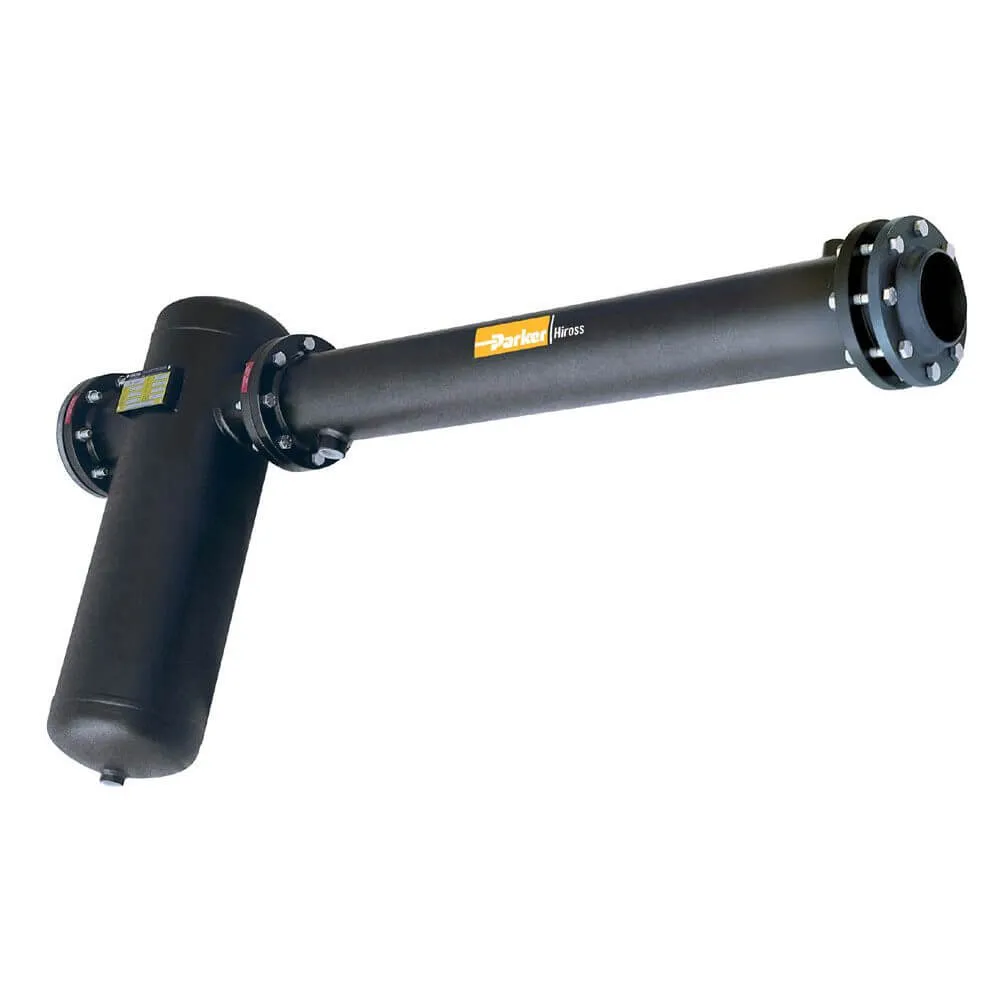
HYPERCOOL WATER COOLED AFTERCOOLER
Compressed air and gases contain high levels of liquid water vapour. Effective water removal leads to reduced maintenance costs, enhanced system operation and improved product quality. Hypercool water cooled aftercoolers represent the vital first step in this process, installed immediately downstream of compressors or blowers they eliminate over 80% of the water present within compressed air and gas systems.
Click to download catalog
Features :
- Fixed or removable tube bundles
- Carbon steel shell and copper tubes for standard applications
- Cupro-nickel shell and tubes for sea water use
- Stainless steel shell and tubes for aggressive gas and/or water
- Carbon steel shell and stainless steel tubes for aggressive air or gas
- High pressures up to 40 barg (up to 80 barg on request) and low pressures down to 1barg
- Stainless steel centrifugal water separators are available on request
AIR OIL COOLER WITH AC MOTOR – LAC SERIES
The Parker LAC air oil cooler series offers a reliable and efficient cooling system with the additional benefits of short lead times and 48 delivery for some part numbers. With its simple and robust design and wide selection of accessories this range will suit all industrial applications with a high voltage electric source.
Click to download catalog
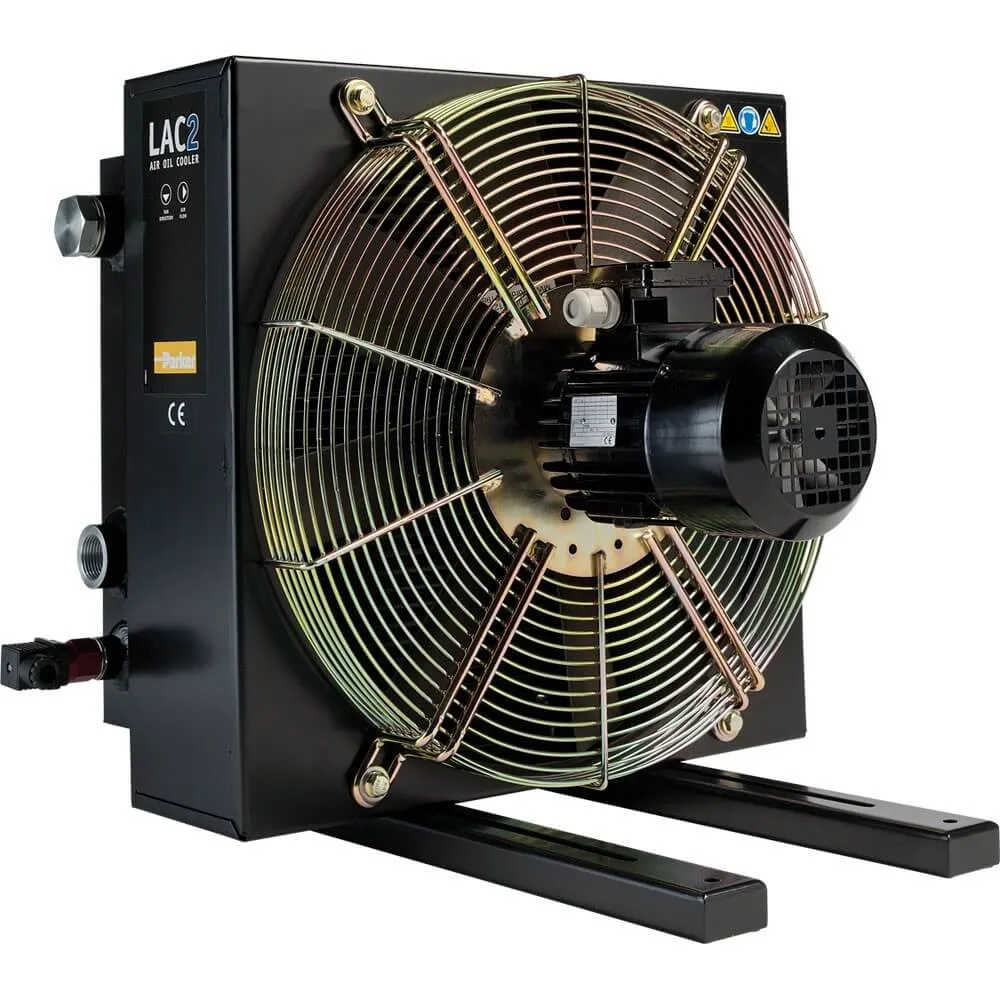
Features/Benefits:
- Quiet fan and fan motor.
- Efficient and robust design which extends operating lifetime and reduces service and maintenance costs
- Cooler matrix with low pressure drop and high cooling capacity.
- Easy to maintain and easy to retrofit in many applications.
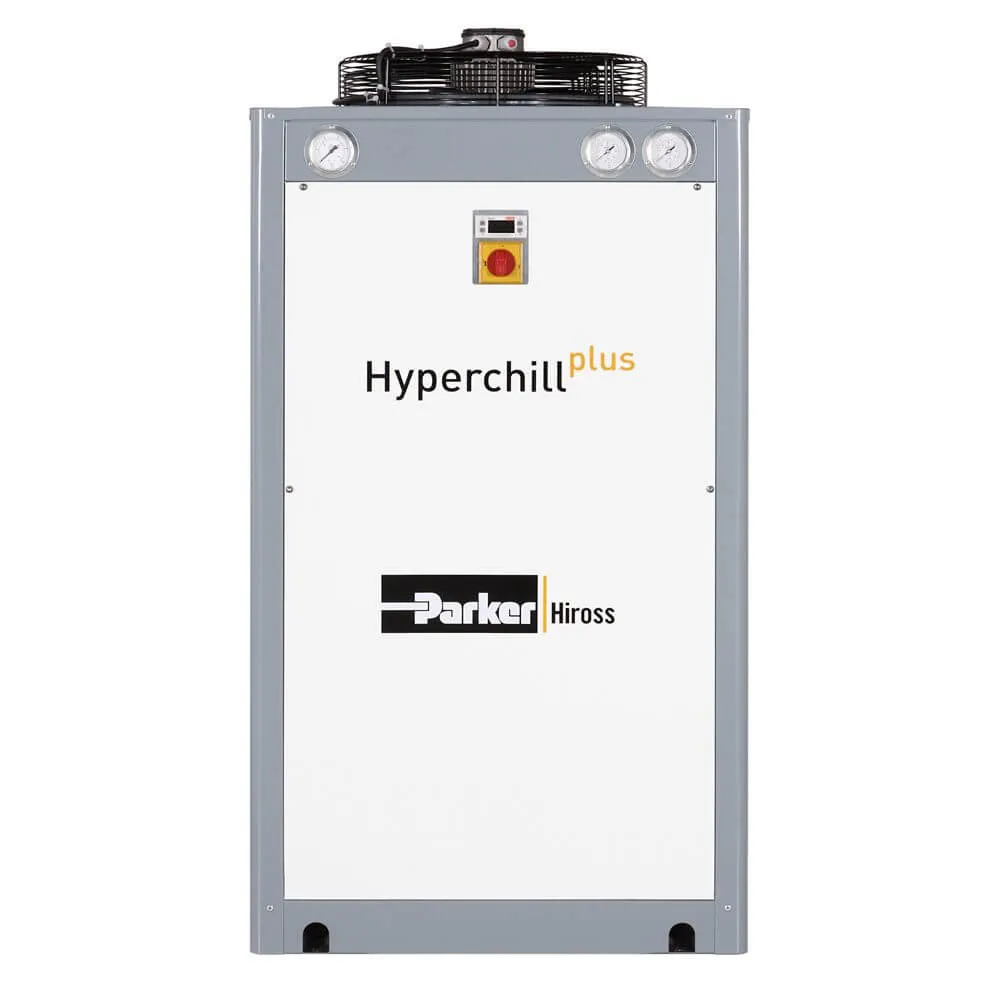
HYPERCHILL PLUS – INDUSTRIAL WATER CHILLER FOR PRECISION COOLING OF LOW VISCOSITY INDUSTRIAL COOLING FLUIDS
Extremely compact and easy to use, Hyperchill Plus is designed for safe and reliable operation in the most varied working conditions, providing precise and accurate control of low viscosity process fluid temperature.
Click to download catalog
Features :
- Complete solution, easy to install and manage
- Non-ferrous hydraulic circuit including non-ferrous water tank
- A differential pressure switch ensures system shut down if the circuit runs dry
- Completely configurable with many options and kits to fit the needs of a wide variety of industrial applications
- Maximum ambient temperature up to 48°C on standard units, tropicalization up to 53°C
- Use of compliant scroll compressors (on ICEP007 and larger)
- Low ambient speed-control (optional)
BRAZED PLATE WATER OIL COOLER – PWO SERIES
With a PWO water oil cooler in your system, you can be assured that the fluid in your system is working at the correct temperature, providing maximum performance and reliability. The cooling elements of the Parker PWO water oil cooler consist of corrugated channel plates sandwiched between the front and rear cover plates. The channel plates are pressed and vacuum brazed in the same automated procedure, with rigorous standards of quality control. The design of the Parker PWO emphasizes a number of possibilities for versatile and efficient solutions.
Click to download catalog

Features/Benefits:
- Light and compact
- Suitable for many applications
- Easy installation
- Cost-efficient and environmentally friendly

AIR OIL COOLER WITH DC MOTOR – LDC SERIES
The Parker LDC air oil cooler series offers a reliable and efficient cooling solution with the additional benefits of short lead times and 48 delivery for some part numbers. This series can be fitted with a Smart DC Drive which provides a smooth fan start, reduced power consumption & noise level and eliminates voltage peaks, all of which contribute towards a longer service life for the fan motor.
Features/Benefits :
- Quiet fan and fan motor.
- Efficient and robust design which extends operating lifetime and reduces service and maintenance costs
- Cooler matrix with low pressure drop and high cooling capacity.
- Easy to maintain and easy to retrofit in many applications.
Click to download catalog

HYPERCOOL AIR COOLED AFTERCOOLER
The Parker Hiross Hypercool range of air cooled aftercoolers represents a cost effective solution to easily remove water vapour from compressed air and cool it to safe usable levels for many industrial applications.A high quality aftercooler, properly sized is an excellent investment that can help ensure that the compressed air system works efficiently, thereby guaranteeing the quality of the finished product.
Features :
- Robust construction and compact design
- Low pressure drop design
- Protective grill for fan and heat exchanger
- High efficiency and low noise axial fans
- Standard protection with epoxy powder coating
- Full range of matching centrifugal separators “Hypersep”
- Extensive range of condensate drains “Hyperdrain”
Click to download catalog
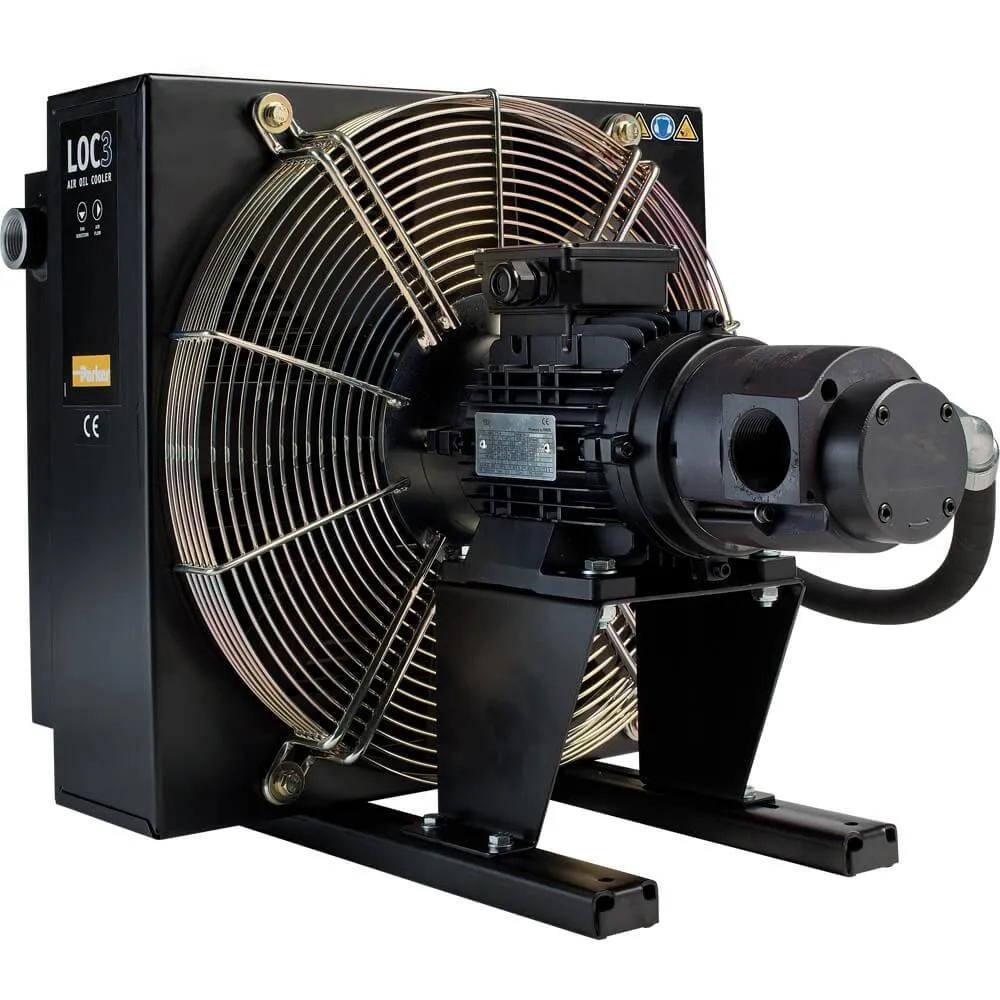
AIR OIL COOLER WITH AC MOTOR & PUMP – LOC SERIES
The LOC cooling system with three-phase AC motor is optimized for use in the industrial sector. The system is supplied ready for installation and an integrated circulation pump makes it possible to cool and treat the oil in a separate circuit – offline cooling. The cooling system can also be equipped with a Parker filter unit. Together with a wide range of accessories, the LOC cooling system is suitable for installation in most applications and environments. The maximum cooling capacity is 45 kW at ETD 40 °C. The maximum cooling capacity is 45 kW at ETD 40 °C.
Features and Benefits:
- Quiet fan and fan motor.
- Efficient and robust design which extends operating lifetime and reduces service and maintenance costs
- Cooler matrix with low pressure drop and high cooling capacity.
- Easy to maintain and easy to retrofit in many applications.
Click to download catalog
CONTROL FLUID TEMPERATURE IN HYDROSTATIC DRIVE CIRCUITS, HYDRAULIC THERMAL BYPASS VALVES, 250 PSI – TH SERIES
TH Series Thermal Bypass Valves are used to modulate fluid temperature by shifting return line flow through the cooler, or bypassing it directly to the reservoir. Additionally, an integral pressure relief function automatically releases excess pressure to the reservoir if the cooler becomes restricted, and the inlet pressure becomes excessive. Relief crack pressure settings range from 5 to 85 psi in 5 psi increments. The TH Series is available in 1″” size and rated for pressures up to 250 psi with a max flow rate 60 gpm. There are five standard shift temperatures.
Click to download catalog

Features and Benefits:
- Ideal for hydrostatic drive circuits requiring fast warm up, controlled fluid temperatures, and low return line back pressure.
- Lightweight, corrosion resistant aluminum housing
- Integral relief valve dumps excess inlet pressure to the reservoir
- Five standard shift temperature options
- Wide range of crack pressure options from 5 to 85 psi

COMPLETE AIR OIL COOLER SYSTEM WITH AC MOTOR – ULOC SERIES
Parker’s ULOC Air Oil Cooler is a stand-alone, offline cooling circuit that offers quiet operation (using a very low noise motor and gerotor pump combination), low pressure drop and high cooling capability. The ULOC design, also referred to in industry as “kidney loop circuit” or “offline circuit”, utilizes a robust bar and plate construction, providing a more efficient and compact design when compared to traditional tube and fin construction. The ULOC Series features three-phase NEMA motors, providing a wide range of available voltages and frequencies.
Click to download catalog
Features and Benefits:
- Up to 60hp of cooling capacity
- Integrated circulation pump produces even flow with low pressure pulsations
- Available with integrated 12CS or 50CS oil filter
- Compact design results in lighter weight
- Reliable and long lasting cooling with low service and maintenance costs
- Quiet fan and pump
- Wide range of UL, CSA, & CE certified AC motors available
- Extra corrosion protection available for use in marine/offshore and extreme applications
- ATEX approval for use in potentially explosive atmospheres above ground
- Several options available: Thermal switch, Pressure bypass, Air filter, Fan guard/screen, etc.
AIR OIL COOLER WITH HYDRAULIC MOTOR – LHC SERIES
The Parker LHC air oil cooler series offers a reliable and efficient cooling solution that is suitable for mobile and industrial applications. The LHC air oil cooler is available with extra corrosion protection, for use in marine/offshore applications (LHC-M) and with ATEX approval for use in potentially explosive atmospheres above ground (LHC-X). The maximum cooling capacity is 300 kW at ETD 40 °C with a hydraulic motor up to 25.2cm³/rev.
Click to download catalog
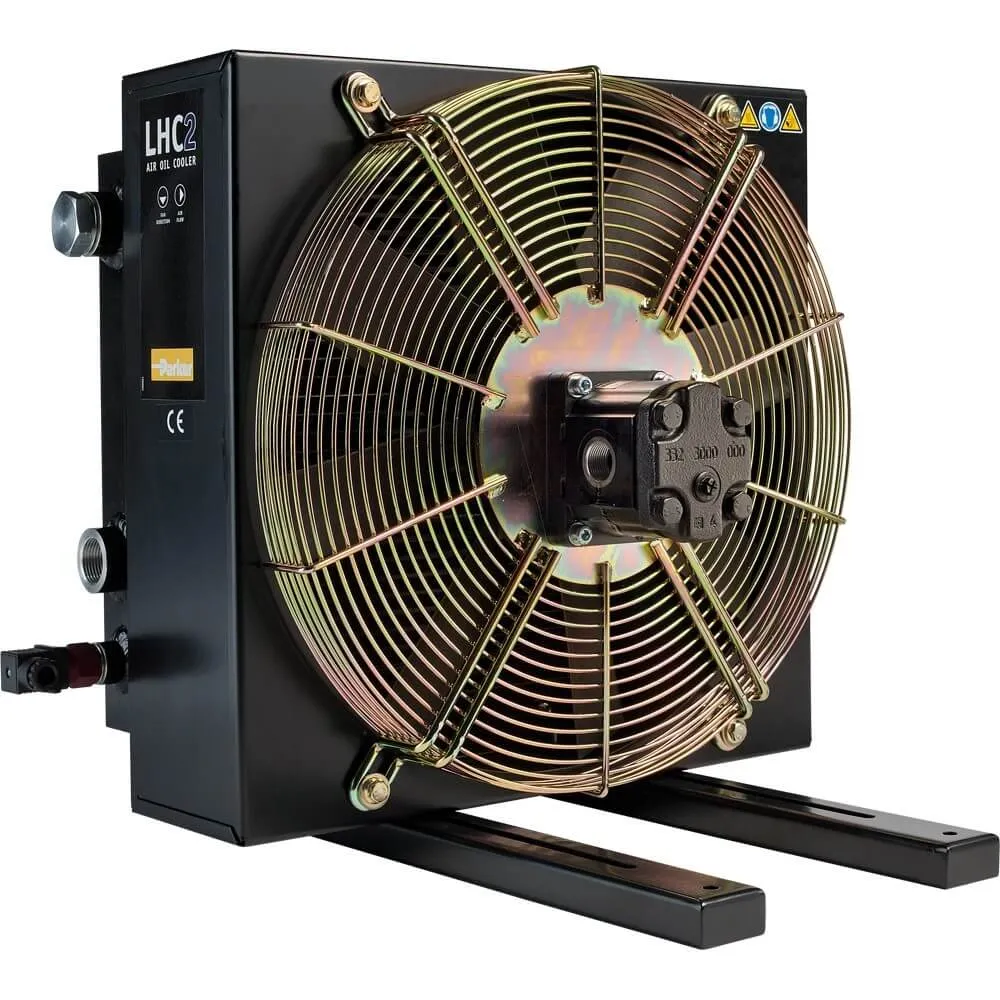
Features and Benefits:
- Quiet fan and motor.
- Efficient and robust design which extends operating lifetime and reduces service and maintenance costs
- Cooler matrix with low pressure drop and high cooling capacity.
- Easy to maintain and easy to retrofit in many applications.
- Hydraulic motor with displacement from 8.4 cm3 /r to 25.2 cm3 /r.
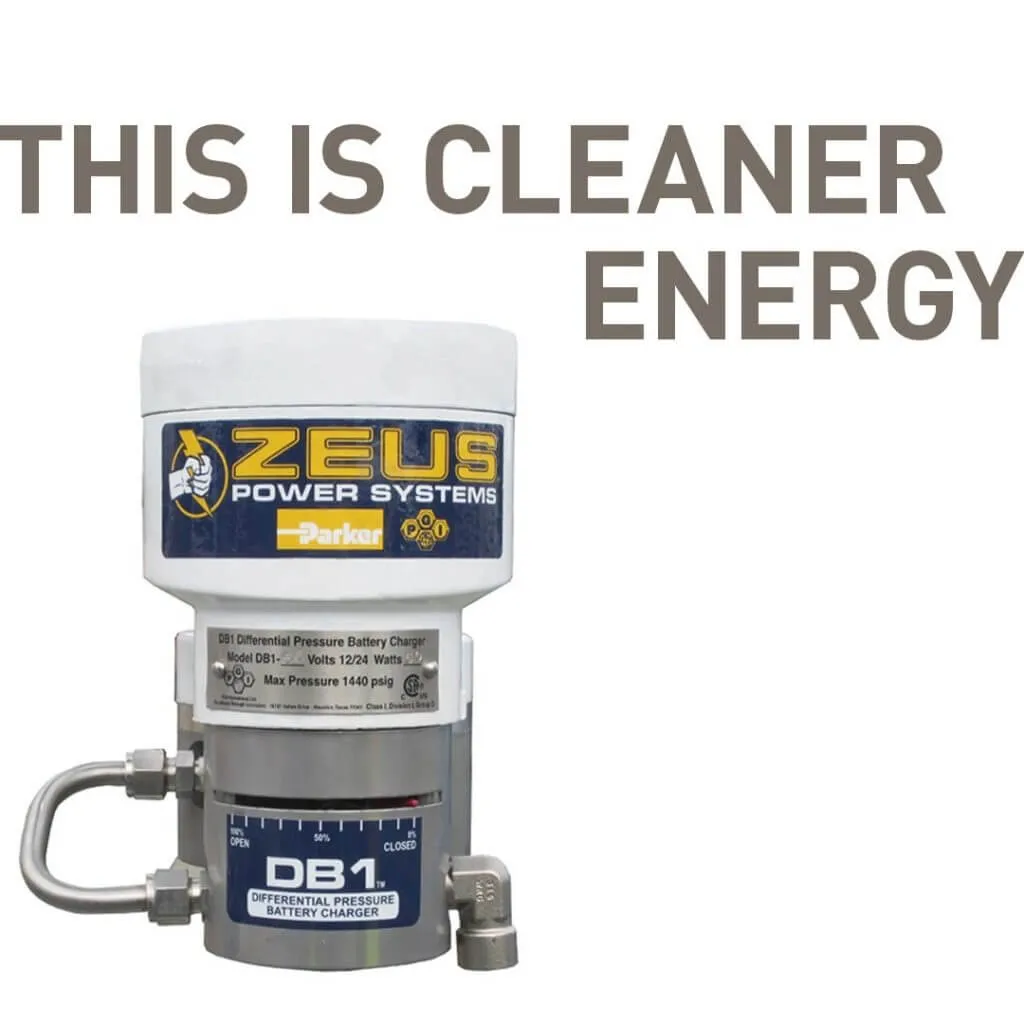
BATTERY CHARGERS, DB DIFFERENTIAL PRESSURE – ZEUS POWER SYSTEMS SERIES
Parker PGI’s DB1 Series Differential Pressure Battery Charger offers free uninterruptible power 24/7. It uses the differential pressure developed across a pressure regulator to operate a small turbine generator which produces power to keep a lead acid / gel cell battery charged. Power is generated by natural gas up to 1440 PSIG system pressure as it flows through the unit from the upstream pressure and then returning to the line on the downstream side. The minimum required pressure differential is 65 psi for 10 Watts, 85 psi for 20 Watts and 125 psi for 50 Watts. DB1 is CSA approved Class I, Div. 1, Group D certified.
Click to download catalog
Features and Benefits:
- Compact
- Microprocessor Controlled
- Remote Control of Battery Charger
- Free uninterruptible power 24/7
- Consumes no gas
- Emission Free
- CLASS 1 , DIV 1,Group D certified
SHELL AND TUBE WATER OIL COOLERS – SWO SERIES
The Parker SWO Water Oil Coolers are manufactured to cater for the most common power requirements in the hydraulics industry. The serialised manufactured units range from the smallest size (TP-A1) with 3 kW of heat dissipation power to the largest size (TP-F6) with 500 kW per average. Two fluids, of different starting temperatures, flow through the water oil cooler. One fluid flows through the internal tubes and the other flows around the tubes inside the shell. Heat is transferred from one fluid to the other through the tube walls, either from inside the tubes to the surrounding fluid or vice versa.
Click to download catalog
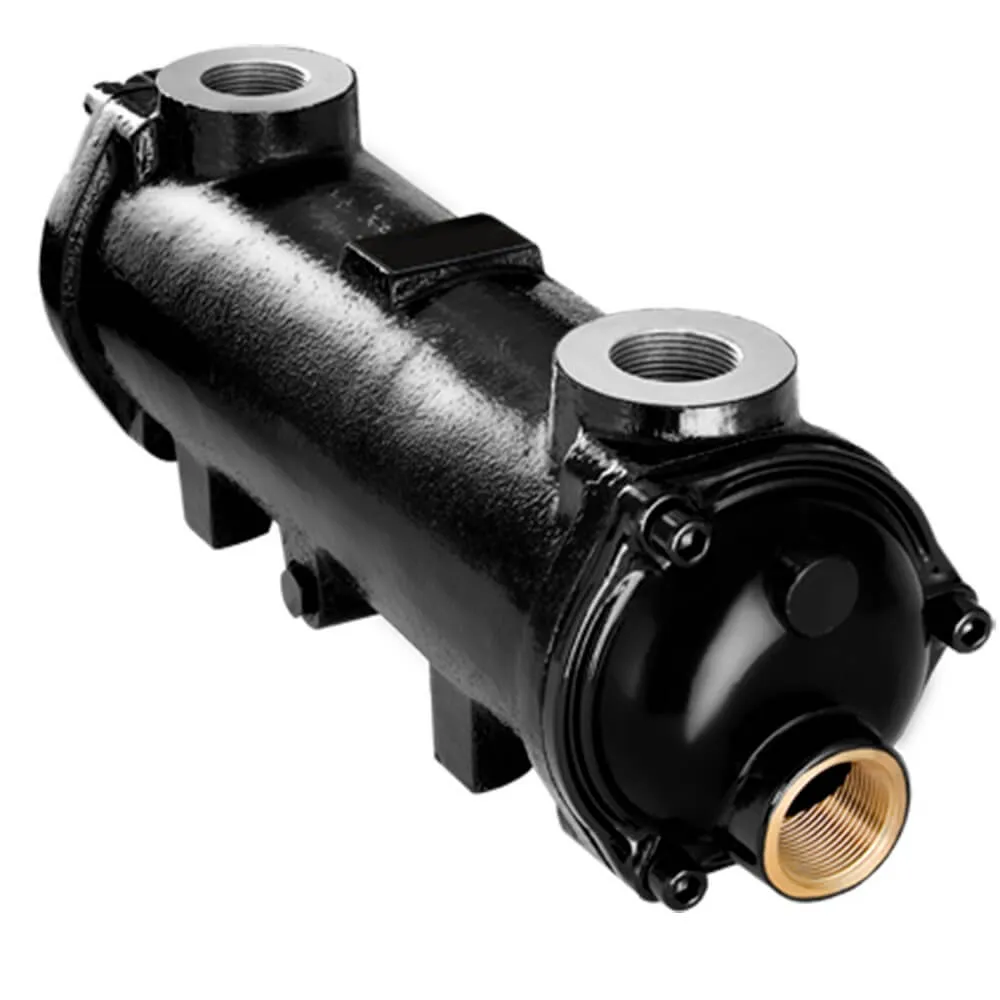
Features and Benefits:
- Light and compact
- Suitable for many applications
- Easy installation
- Cost-effective and environmentally friendly
- The shell is made from cast aluminium/bronze, finely machined to accept the tube bundle with no friction and accurate tolerances. All shell ports are machined by CNC equipment to provide the highest degree of accuracy.
- End covers are bolted type to allow access to the tube bundle for maintenance. Made from gun metal and hot pressed brass as standard to prevent corrosion.
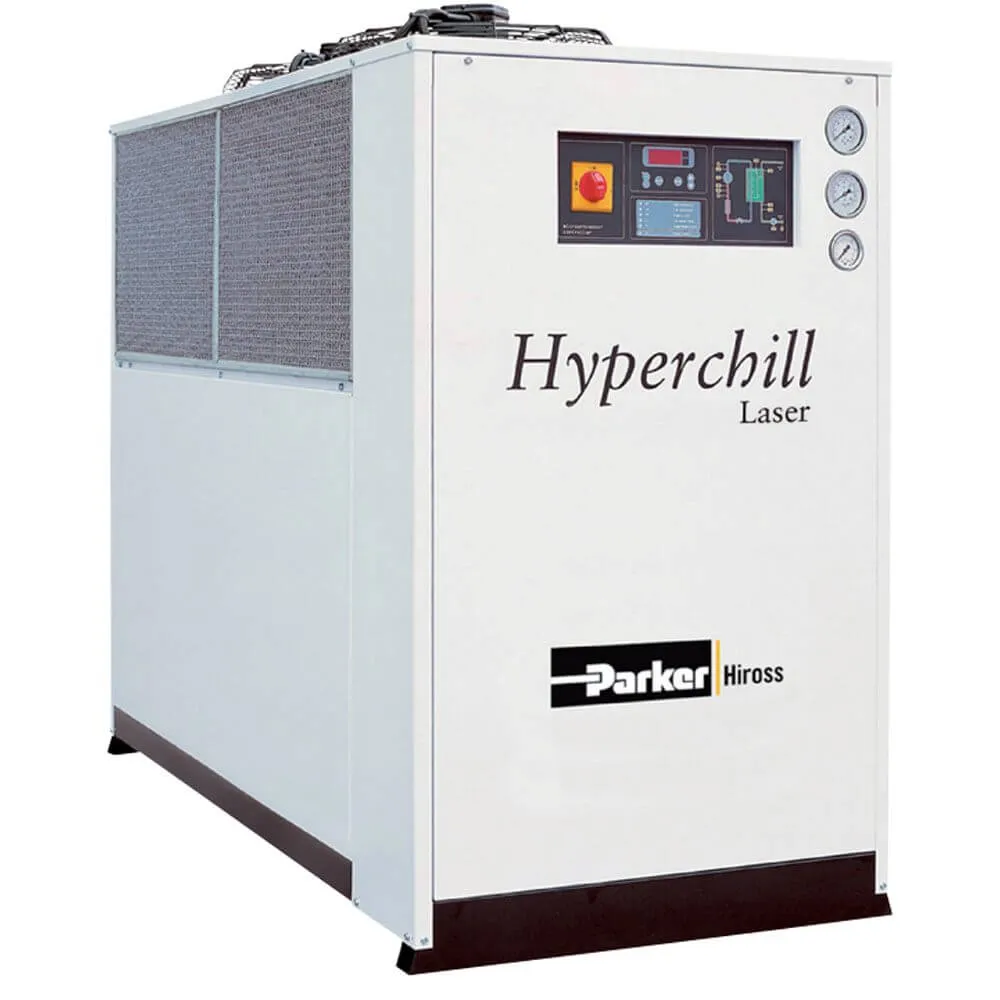
HYPERCHILL LASER INDUSTRIAL PROCESS CHILLER FOR PRECISION COOLING
The performance of high-powered lasers depends on effective cooling. High-powered lasers generate a significant amount of heat that must be removed from the laser system to avoid overheating critical components. Carbon dioxide (CO2) lasers, excimer lasers, ion lasers, solid-state lasers, and dye lasers all use liquid cooling to remove excess heat. Laser liquid cooling can help accomplish three goals:
Click to download catalog
- Maintaining a precise laser wavelength and higher output efficiency
- Achieving desired beam quality
- Reducing thermal stress on a laser system.
Features :
- Complete solution, easy to install and manage
- Non-ferrous hydraulic circuit including non-ferrous water tank
- A differential pressure switch ensures system shut down if the circuit runs dry.
- Maximum ambient temperature up to 48°C on standard units, tropicalization up to 53°C
- Use of compliant scroll compressors (on ICEP007 and larger)
- Low ambient speed-control (optional)

